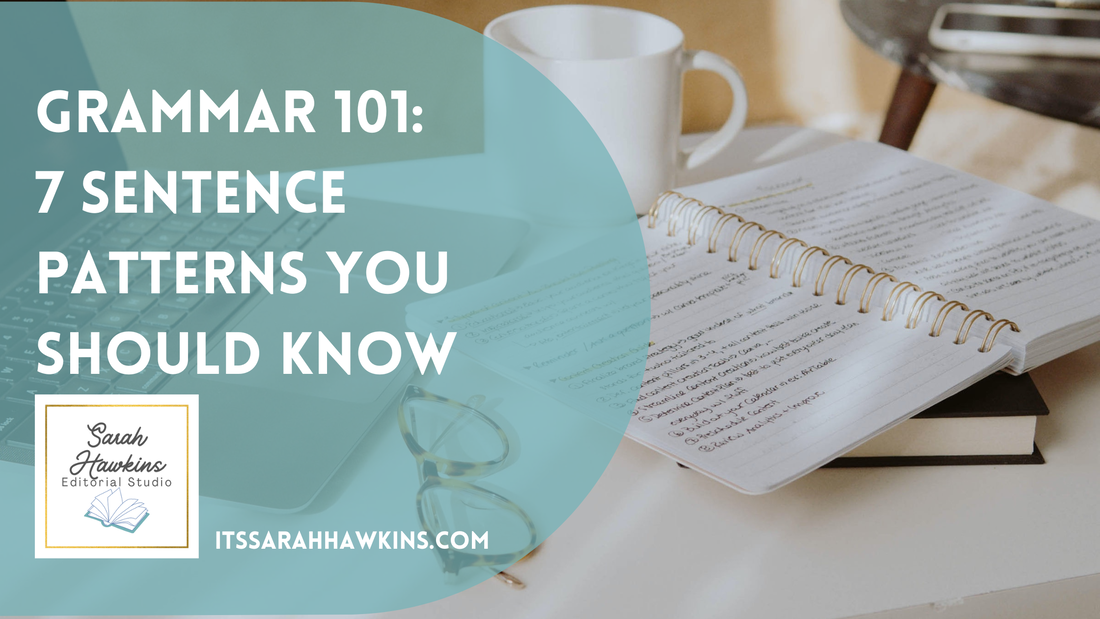What's covered in this post
IntroductionYou need a good foundation in grammar to curate and intentionally use your style. So, we are embarking on the Grammar 101 section of the Style Series. This week we’re going to learn all about the 7 basic sentence patterns. Be patterns Be patterns involve any verbs derived from the infinitive “to be.” They include is, am, are, were, was, been, and being. Being Verbs have a bad reputation as weak verbs, but when used correctly, they can be powerful. There are two basic sentence patterns that use being verbs: In the first pattern, the being verb is followed by an adverbial . An adverbial is any structure that modifies a verb. But in this pattern, it is usually an adverbial of time or place, or answers the questions When? or Where? Example: She is in the chair. She + is + in the chair = Subject + Be + Place Adverbial (where) In the second pattern, the being verb is followed by a subject complement, which is either an adjective or a noun phrase called a referent. Referents rename the subject while adjectives describe the subject. Examples: The playroom is a mess. The playroom + is + a mess = Subject + Be + Referent The playroom is messy. The playroom + is + messy. = Subject + Be + Adjective Linking verb patternLinking verbs are all verbs other than “to be” that are completed by a subject complement, such as taste, smell, feel, become, remain, look, appear, seem, and prove. There is only one basic sentence pattern that utilizes linking verbs: But the linking verbs still serve different functions. The sensory-based linking verbs (taste, smell, etc.) usually link the subject to an adjective. Example: This book smells amazing. This book + smells + amazing = Subject + Linking Verb + Adjective Other linking verbs, such as become and remain, link a noun to a referent. Example: This house remains a mess. This house + remains + a mess = Subject + Linking Verb + Referent Intransitive verb patternAn intransitive verb is an action verb (also considered a “strong” verb) that doesn’t take a direct object, such as ran, jump, laugh, and bark. Therefore, the intransitive verb pattern is the simplest pattern. Example: The T-rex ran. The T-rex + ran = Subject + Intransitive Verb Transitive verb patternsLike intransitive verbs, transitive verbs are action verbs. But transitive verbs take a direct object, which is a noun phrase that answers the question of What? or Whom? There are three basic sentence patterns that use transitive verbs: In the first pattern, the transitive verb and direct object complete each other. You don’t need anything else to understand the core sentence. Example: We eat pizza. We + eat + pizza = Subject + Transitive Verb + Direct Object In the second pattern, an indirect object completes the meaning of the sentence. An indirect object refers to whatever receives the direct object, or whomever the action is performed for. Example: TikTok gave many writers a community. TikTok + gave + many writers + a community = Subject + Transitive Verb + Indirect Object + Direct Object In the third pattern, an object complement follows the direct object. Like a subject complement, an object complement is a noun or phrase. But an object complement describes the direct object. Example: My son calls quesadillas piñatas. My son + calls + quesadillas + piñatas = Subject + Transitive Verb + Direct Object + Object Complement Exercise 2: Identifying Your Sentence Patterns
0 Comments
Leave a Reply. |
AuthorSarah Hawkins is a geek for the written word. She's an author and freelance editor who seeks to promote and uplift the authors around her. Categories
All
Archives
December 2023
|






 RSS Feed
RSS Feed
